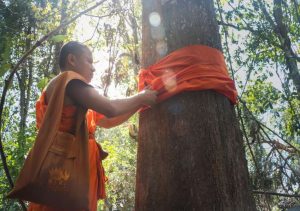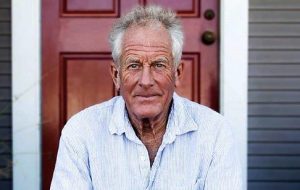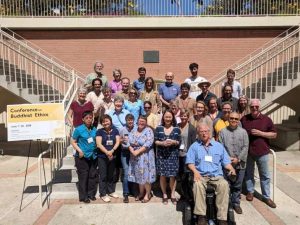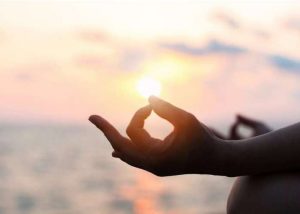
In all of the most prominent and prestigious Buddhist temples in China, signs and billboards make it clear that “authentic Buddhism” entails patriotic service to the country and the Chinese people. This is the case wherever one goes, be it White Horse Temple in Luoyang (the purported first temple in the country), Famen Temple near Xi’an (where a finger bone relic of the Buddha was discovered in a secret subterranean sanctuary in 1987), Kumarajiva Temple in Wuwei, Leiyin Temple in Jiuquan, and so on.
That the sangha flourishes when the country is strong—in the specific lingo, fu qiang: wealthy and powerful—is not an old idea and has two broad antecedents. The first one is the age-old imperial inheritance of church and state as one where China’s sangha protects and helps the people. In turn, the state extends its seal of support and legitimacy to the great temples.
This has been the case since at least the Tang dynasty, during which we know there were imperial registries of state-approved monks and their monastic holdings and where the idea of Buddhism protecting the state reached its zenith of influence and reach under Amoghavajra (705–74) and his fearsome ability—which later on became his unique school of zhenyan or tangmi—to call upon esoteric Buddhist deities to bring perdition and ruin upon the emperor’s enemies.
In modern times, such authenticity can be conferred on movements, individuals, and ideas by the Buddhist Association of China (BAC), such as when the Association approved Ven. Longlian’s (1909–2006) Dual Ordination system for bhikshunis in 1982 (Bianchi 2022, 9–10). Zhao Puchu (1907–2000), the powerful layman and president of the BAC, proclaimed her foremost bhikshuni in modern China.

The second antecedent is the preoccupation of modern Chinese Buddhism on the division between “superstitious” (mixin) Buddhism and authentic Buddhism. This entails many things and some of its most famous proclamations come from the Humanistic Buddhist tradition propagated by Master Hsing-yun (1927–2023) and ideological predecessors like Master Taixu (1890–1947). At one level, this dichotomy simply meant the need to practice authentic Buddhism rather than a diluted, muddled mishmash of Buddhist and other folk or Daoist beliefs. As Hsing-yun wrote:
For over two thousand years, traditional Buddhism has been tainted by beliefs that, under the disguise of Buddhism, preached superstition such as divination by time, fengshui, geography, picking sticks, and fortune telling. Buddhism had almost been turned into a superstitious belief that worships deities and spirits.
(Fo Guang Shan Institute of Humanistic Buddhism)
Beyond rejecting geomancy or Daoist-tinged ideas, seminal reformers of Chinese society in the 19th century such as Liang Qichao (1873–1929) weighed in on authentic Buddhism even before the stirrings of formal Humanistic Buddhism, arguing that: “The Buddhist faith is one of wisdom, not superstition. It emphasizes the greater good over the lesser good, and advocates this-worldly mindset over an other-worldly one.” (Fo Guang Shan Institute of Humanistic Buddhism). This modernist idea of Buddhism “for this life” rather than for the hereafter was something that would be taken up by many Buddhist reformers in varying formulations and creeds. The two dominant institutional schools of Buddhism, Chan and Pure Land, stress that despite having transcendent objectives, the actual practice is not only done but also realized in the present, with results accordingly visible and beneficial to society.
We have touched upon Buddhist authenticity in several forms: authenticity as state-approved and sanctioned, authenticity as doctrinally set apart from other belief-systems—with Western ideas of religion as a clear-cut category actually spurring on this intellectual reconfiguration of the Buddha-dharma—and authenticity as a kind of “correct belief.” These factors coalesced into a coherent tapestry of what Sinologist and Buddhism in modern China expert Ester Bianchi calls a tapestry of “various forms of Buddhist modernisms” (Prof. Bianchi teaches at the Department of Philosophy, Social Sciences and Education at the University of Perugia). This tapestry includes:
. . . the adoption of a text-oriented approach and a modern notion of Buddhism as a world religion, the search for a ‘pure’ and ‘original’ Buddhism, an emphasis on meditation, discourses on gender equality, and the establishment of modern forms of education for the Buddhist clergy.
(Bianchi 2021, 12)

But there is a final form of authenticity that goes bone-deep into the tradition: the concern that whether the Vinaya, as received in the country of China and therefore transmitted to monastics, is legitimate. This haunting worry is revealed in a little-known speech by a very accomplished and influential monastic and reformer, Hongyi (1880–1942) who confessed in 1933 to a small group of followers that his clerical ordination was so flawed that the transmission was basically ineffective (Birnbaum 2023, 23), and since Vinaya is the very foundation of the Buddhist Dharma (Bianchi 2020, 64), the problem is of grave import:
. . . although he had dedicated his energies since the year of his (flawed) ordination to what had become widely recognized by peers as foundational studies of precepts and their transmission rites, in fact he himself was not a precept holder. Nor perhaps was anyone else around him. In the current age there no longer was a way that the full complement of biqiu precepts or even the ten novice precepts could in a genuine sense be received through the customary transmission rites.
(Birnbaum 2023, 55)
We can look on the earlier example of Longlian’s success in re-establishing the Dual Ordination for women as a possible answer to this quandary. It was a state-approved resurrection or revival (huifu 恢复) of the bhikshuni lineage, which while technically was not the first in modern Asia, was of great political significance in China, as described in Prof. Bianchi’s paper analyzing contemporary Dual Ordination. (Bianchi 2020, 9; 10) This was only possible through “the establishment of legitimate ordination criteria,” (Bianchi 2020, 8) which implies that authenticity can only be maintained if keeping this “legitimate criteria” is the watchword of the entire nation’s sangha.
The experience of Hongyi, and his long struggle to accept the faultiness of his ordination, might seem trivial or a minor procedural issue to a non-Buddhist outsider, but should send a chill down the spine of every serious practitioner. This unease is, positively framed, an unrelenting devotion to the authentic Vinaya as well as doctrinal teachings. It has been so since the era of the pilgrim-monks like Xuanzang (602–64). He already had a pervading sense, a great unease, that the Buddha-sāsana that had arrived in China centuries before his time was incomplete, inaccurate, or lacking in at least some way that could not be overlooked or brushed aside.
That historical sense of incompleteness spurs on the historic mission of Chinese Buddhists, if not in content, at least in a similar urgency as the grand political project of unification since the Qin-Han era. Especially when fused with a distinct consciousness of past decline that had been weighing on Chinese Buddhism as recently as the 20th century, the integration of these layers of authenticity is mission critical. Otherwise, the heart of not only monastics and laypeople, but the entire sangha, and therefore the nation, remains restless.
References
Ester Bianchi. 2022. “Reading Equality into Asymmetry: Dual Ordination in the Eyes of Modern Chinese Bhiksunis.” In Religions 13: 919. https://doi.org/10.3390/ rel13100919.
___ 2021. “Revisiting Impurity in Republican China: An Evaluation of the Modern Rediscovery of Bujing guan 不淨觀.” In Religions 12: 903. https://doi.org/ 10.3390/rel12100903.
___ “Understanding Jielü 戒律: The Resurgence and Reconfiguration of Vinaya-Related Concepts in Modern China.” In Volume II Intellectual History of Key Concepts, edited by Gregory Adam Scott and Stefania Travagnin, Berlin, Boston: De Gruyter, 2020, pp. 55-80. https://doi.org/10.1515/9783110547825-004
Birnbaum, Raoul. In Ester Bianchi and Daniela Campo (eds.). “Vinaya Master Hongyi’s 弘一Vinaya Problem,” in “Take the Vinaya as Your Master”: Monastic Discipline and Practices in Modern Chinese Buddhism. Leiden and Boston: Brill, 23–94.
Goble, Geoffrey C.. 2019. Chinese Esoteric Buddhism: Amoghavajra, the Ruling Elite, and the Emergence of a Tradition. New York: Columbia University Press
See more
Humanistic Buddhism: Holding True to the Original Intents of Buddha Foreword (Fo Guang Shan Institute of Humanistic Buddhism)
Related news from BDG
Taiwanese Buddhist Association Donates Relics to China
Related blog posts from BDG Tea House
From the Capitals to the Corridor: A Visit to China’s Silk Road
State Sangha: Buddhism for the People
Conservation matters to China. It should be a core Chinese Buddhist concern














What I read in the sutras says not to criticize other schools, practitioners, etc. Is this not the supposed words of the Buddha? I fully support anyone researching the Buddha-Dharma, however I don’t take part in an apparent ‘one up manship’. Seems a bit egocentric is it not?